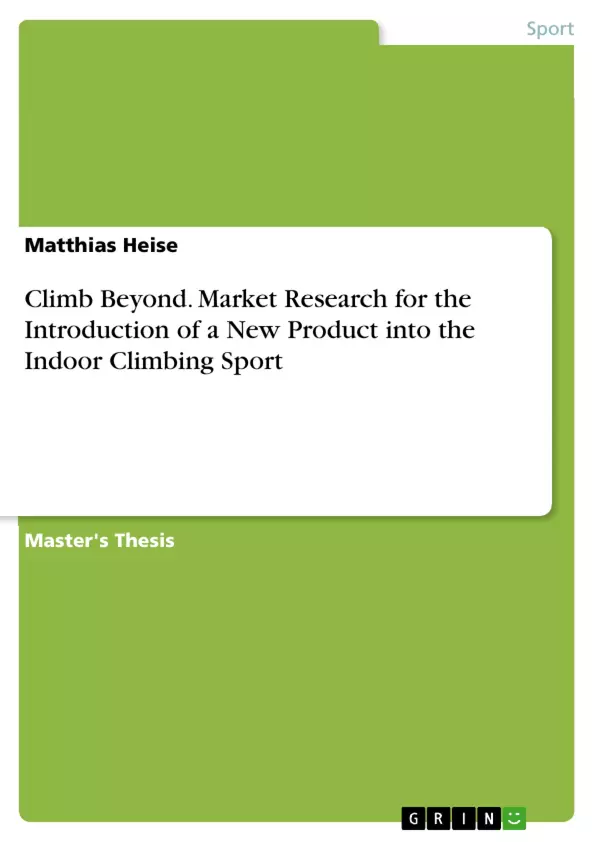For about two decades indoor climbing became a trend in adrenalin sports. In many Western countries climbing halls of huge size have been build. Most urbanized citizens at least tried it once. But even though the climbing community is huge, only a few starters remain active or advance in skills and techniques. The business background of this research is a new product that is able to track the movement of any professional climber and re-project the shape of the body to help an inexperienced climber to make his next best move while being stuck on the wall. This will help less skilled users to advance and enjoy climbing even more. The applications for this product are numerous but the market is highly uncertain. Therefore this study tries to reveal why most users
do not advance and it identities common problems and barriers that most climbers
have to face. How do they get over them or why do they stumble. After having
a deeper insight into the indoor climbing market, the possible market size and user acceptance for the new product can be estimated more accurately. This thesis is seen as an opportunity assessment reducing uncertainty before bringing the product into the market.
Inhaltsverzeichnis (Table of Contents)
- Abstract
- Special Thanks
- 1. Introduction
- 1.1. Introduction to the Topic
- 1.2. Problem Definition
- 1.3. Research Questions
- 1.4. Scope of the Thesis
- 1.5. Structure of the Thesis
- 2. Theoretical Framework
- 2.1. Market Segmentation and Target Group Analysis
- 2.1.1. Market Segmentation and Targeting
- 2.1.2. Customer Relationship Management
- 2.1.3. Needs and Problems of the Target Group
- 2.2. Innovation and Technology
- 2.2.1. Definition of Innovation
- 2.2.2. Diffusion of Innovation
- 2.2.3. The Innovation Funnel
- 2.2.4. Technology Acceptance Model (TAM)
- 2.3. Marketing and Sales
- 2.3.1. Market Entry Strategies
- 2.3.2. Pricing Strategy
- 2.3.3. Product Placement and Distribution
- 2.3.4. Product Communication and Promotion
- 3. Methodology
- 3.1. Research Design
- 3.2. Data Collection
- 3.2.1. Literature Research
- 3.2.2. Industry Analysis
- 3.2.3. Expert Interviews
- 3.2.4. Survey
- 3.2.5. Secondary Research
- 3.3. Data Analysis
- 4. Results
- 4.1. Market Analysis
- 4.1.1. Market Size and Growth
- 4.1.2. Competitive Landscape
- 4.1.3. Target Group Analysis
- 4.2. Product Analysis
- 4.2.1. Product Features and Benefits
- 4.2.2. Product Development and Innovation
- 4.3. Marketing and Sales Analysis
- 4.3.1. Marketing Strategy
- 4.3.2. Sales Strategy
- 4.3.3. Pricing Strategy
- 4.3.4. Distribution Strategy
- 5. Discussion
- 5.1. Interpretation of Results
- 5.2. Recommendations for Action
- 5.3. Conclusion
Zielsetzung und Themenschwerpunkte (Objectives and Key Themes)
This thesis aims to assess the market potential of a new product designed to improve the experience of indoor climbers. It explores the challenges faced by climbers, identifies key market trends, and analyzes the potential user acceptance of the product. The main objectives are: * To understand the motivations and barriers faced by indoor climbers, particularly those who do not advance in their skills. * To analyze the existing market for indoor climbing equipment and services. * To evaluate the potential of the new product to meet the needs of the target market. * To identify potential market entry strategies for the product. * To provide recommendations for the successful introduction of the product into the market.Zusammenfassung der Kapitel (Chapter Summaries)
- Chapter 1: Introduction: This chapter sets the scene by introducing the concept of the new product and outlining the research questions and objectives of the study. It defines the scope of the thesis and provides a brief overview of the structure of the work.
- Chapter 2: Theoretical Framework: This chapter lays the groundwork for the research by exploring relevant theories from the fields of marketing, innovation, and technology adoption. It examines concepts such as market segmentation, customer relationship management, innovation diffusion, and the Technology Acceptance Model (TAM).
- Chapter 3: Methodology: This chapter outlines the research design and methodology used in the study. It explains the data collection methods, including literature research, industry analysis, expert interviews, and a survey, as well as the data analysis techniques employed.
- Chapter 4: Results: This chapter presents the findings of the research, including market analysis, product analysis, and marketing and sales analysis. It discusses the size and growth of the market, identifies key competitors, analyzes the target group, and explores the features, benefits, and potential development of the new product.
Schlüsselwörter (Keywords)
The primary keywords of this work are: indoor climbing, market research, innovation, product development, target group analysis, marketing strategy, market entry strategy, user acceptance, and product adoption.- Quote paper
- Dipl.-Inf. Matthias Heise (Author), 2012, Climb Beyond. Market Research for the Introduction of a New Product into the Indoor Climbing Sport, Munich, GRIN Verlag, https://www.grin.com/document/263895



